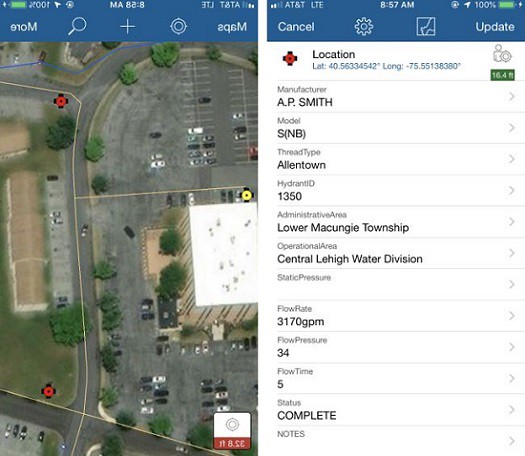CASE STUDY
Apps and Insights Drive Smarter Decision-Making
Lehigh County Authority in eastern Pennsylvania is a medium-sized water and wastewater service provider to over 55,000 residents of the Lehigh Valley. The authority's large system includes 660 miles of water main, 405 miles of sewer main, and 3,700 fire hydrants spread out over a 40-mile service area from the main operations center. There was a need to push the geographic information system (GIS) out into the field to improve operational efficiencies and transition from paper to digital record keeping.
The Challenge
Lehigh County Authority needed field workflows to become more efficient. The first step was to evaluate the fire hydrant flushing program. On an annual basis, crews from the authority would flush 1,500 fire hydrants. They relied on paper maps and worked off old work orders to track progress and report deficiencies. Results would remain dormant in the filing system, rarely accessed. Updating this workflow would improve the quality of data reporting as well as empower supervisors to track progress throughout the program.
The Solution
The GIS team worked with the Operations Department to determine what data was needed to create a digital workflow for fire hydrant flushing. The data was hosted in ArcGIS Online, and Collector for ArcGIS was configured to collect flushing data. The team spent a week training the operations staff members on the use of Collector for ArcGIS.
Supervisors managing the flushing program were also given a new tool: Operations Dashboard for ArcGIS. Configuring Operations Dashboard with the same datasets used in Collector for ArcGIS provided supervisors with a real-time view of work being completed in the field.
Using the ArcGIS platform, specifically Collector for ArcGIS, the GIS team took three weeks to configure, train, and release a mobile application to transform the existing hydrant flushing program.

"Using Collector for ArcGIS was a significant turning point, transitioning from paper files to digital files. It empowered our staff to capture valuable information in a quicker, more efficient way."
Nathan Roush - Operations Supervisor, Lehigh County Authority
The Results
Moving from paper reports to digital reporting was a big success. This transition saved operations staff five minutes on every hydrant. The authority saved $3,500 in labor and roughly $500 in vehicle and equipment expenses, for a total of $4,000 in operational savings with this one project.
In addition to this monetary benefit, crews can now collect flow data on every hydrant; operate the hydrant isolation valve in the same visit; and create work orders in the field, identifying future needs (e.g., paint, defenders). Another benefit is that the data from the flushing program is digital, making it available to be used for analysis. The authority combined this data with water main data using Insights for ArcGIS. By comparing the hydrants and mains, the authority was able to identify areas that should be prioritized for leak investigation. This saved labor costs by preventing the authority from mobilizing equipment to areas that were not a priority.
Eliminating the paper workflow saved the time previously spent looking through paper maps, manually trying to find hydrant numbers, and writing down the flushing data. That time is now used to complete flushing more efficiently as well as collect and share accurate data in real time.